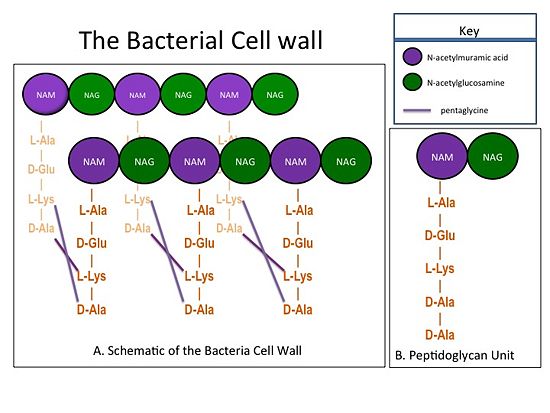Sandbox 126
From Proteopedia
(Difference between revisions)
| Line 5: | Line 5: | ||
==='''Background Information'''=== | ==='''Background Information'''=== | ||
| - | The bacterial cell wall is composed of sheets of peptidoglycan cross-linked together to form a highly polymeric "mesh" that helps maintain the structural strength of the cell (Figure 1). A peptidoglycan sheet consists of alternating residues of <font color='purple'> '''N-acetylmuramic acid (NAM)''' </font> and <font color='green'> '''N-acetylglucosamine (NAG)''' </font> linked together by β-(1,4)- glycosidic bonds. In ''Staphylococcus aureus'' (S. aureus), the NAM residues are coupled to a (D-Ala) residues. The sheets of peptidoglycan are cross-linked together with pentaglycine chains. The cross-linking of adjacent peptidoglycan sheets is catalyzed by transpeptidases (TP). Beta-Lactam antibiotics, such as penicillin and the anti-MRSA cephlosporins, ceftobiprole and ceftaroline, stop the production of the cell wall, and so kill bacteria, by irreversibly inhibiting TPs. Therefore, TPs are also called penicillin-binding proteins. | + | The bacterial cell wall is composed of sheets of peptidoglycan cross-linked together to form a highly polymeric "mesh" that helps maintain the structural strength of the cell (Figure 1). A peptidoglycan sheet consists of alternating residues of <font color='purple'> '''N-acetylmuramic acid (NAM)''' </font> and <font color='green'> '''N-acetylglucosamine (NAG)''' </font> linked together by β-(1,4)- glycosidic bonds. In ''Staphylococcus aureus'' (S. aureus), the NAM residues are coupled to a (D-Ala) residues. The sheets of peptidoglycan are cross-linked together with pentaglycine chains. The cross-linking of adjacent peptidoglycan sheets is catalyzed by transpeptidases (TP). Beta-Lactam antibiotics, such as penicillin and the anti-MRSA cephlosporins, ceftobiprole and ceftaroline, stop the production of the cell wall, and so kill bacteria, by irreversibly inhibiting TPs. Therefore, TPs are also called penicillin-binding proteins.[[Image:CellWall.jpg|thumb|alt= Alt text| Figure 1.(A)Rows of Peptidoglycans forming a Bacterial Cell Wall (B)Peptidoglycan with D-Ala-D-Ala substrate |550px]] |
| + | |||
PBP2a is composed of two domains: <font color='orange'> '''a non-penicillin binding <scene name='37/372726/Npb/4'>(NPB)</scene> domain'''</font> (residues 27-326) and a <font color='dodgerblue'> '''transpeptidase''' </font> <scene name='37/372726/Tp/5'>(TP)</scene> domain (residues 327-668). The NBP domain of PBP2a is anchored in the cell membrane, while the TP domain "sits" in the periplasm with its active site facing the inner surface of the cell wall. The active site contains a serine residue position 403 <scene name='37/372726/Ser403/2'>(Ser403)</scene> which catalyzes the cross-linking of the peptidoglycan rows with pentaglycine cross-links. | PBP2a is composed of two domains: <font color='orange'> '''a non-penicillin binding <scene name='37/372726/Npb/4'>(NPB)</scene> domain'''</font> (residues 27-326) and a <font color='dodgerblue'> '''transpeptidase''' </font> <scene name='37/372726/Tp/5'>(TP)</scene> domain (residues 327-668). The NBP domain of PBP2a is anchored in the cell membrane, while the TP domain "sits" in the periplasm with its active site facing the inner surface of the cell wall. The active site contains a serine residue position 403 <scene name='37/372726/Ser403/2'>(Ser403)</scene> which catalyzes the cross-linking of the peptidoglycan rows with pentaglycine cross-links. | ||
Revision as of 17:37, 31 July 2014
| |||||||||||

